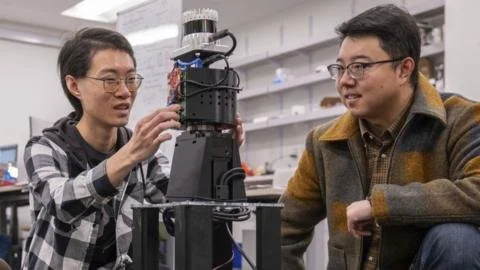Unlocking 'Superhuman' Vision: How Radio Waves Are Revolutionizing Robot Sensing Systems
Innovative Radio-Based Sensing for Robots
Researchers at the University of Pennsylvania are pioneering a groundbreaking method for robots to see through challenging conditions such as smoke and rain, using a novel radio-based sensing system. The technology, which utilizes radio waves, could transform search-and-rescue missions and enhance the capabilities of autonomous vehicles by enabling them to visualize environments where traditional sensors fall short.
Challenges and Incidents
A recent experiment went awry when a smoke machine triggered a fire alarm, highlighting the fun yet hazardous nature of testing this new technology. The experiments aim to develop systems that mimic superhuman vision, allowing robots to detect concealed objects and navigate through complex environments.
Technology Overview
Unlike standard optical sensors like cameras or Lidar, this unique approach leverages an artificial intelligence system that interprets the reflections of radio waves to create a 3D map of the surroundings. This method enables robots to generate visual data even in obstructed or visually challenging situations. Prof. Mingmin Zhao, who leads the project, envisions a future where such technologies could save lives by helping rescue teams locate individuals in calamities.
Specifications of the Radio Waves
Operating in the millimeter wave band, the robot’s radar-like technology is comparable to some existing 5G installations. The length of radio waves allows them to penetrate through obstacles like smoke, providing significant advantages over visible light sensors which are blocked by small particles.
Comparison to Other Technologies
While the current device employs a spinning mechanism to collect data, researchers like Fabio da Silva propose alternative systems that simulate echolocation. Such systems can continuously survey environments without the need for mechanical rotation.
Broader Applications and Ethical Considerations
The potential of radio waves in surveillance and security has sparked interest among military and law enforcement agencies. While the technology holds promise for humanitarian uses, there are ethical concerns regarding its potential applications in warfare and privacy invasion. Prof. Reinhard points out that while radar raises alarms, the widening accessibility of drones and consumer-grade cameras poses more immediate risks.
Future Horizons
Emerging technologies like terahertz waves are also being explored, which could enable deeper analysis of materials and identification of substances. In essence, while this radio wave-based sensing technology could redefine robot operations and emergency responses, it also opens a Pandora’s box of implications that society must carefully navigate.

